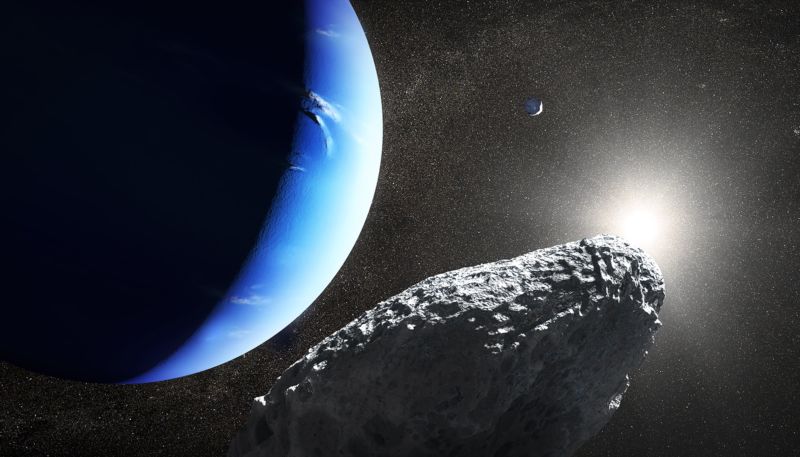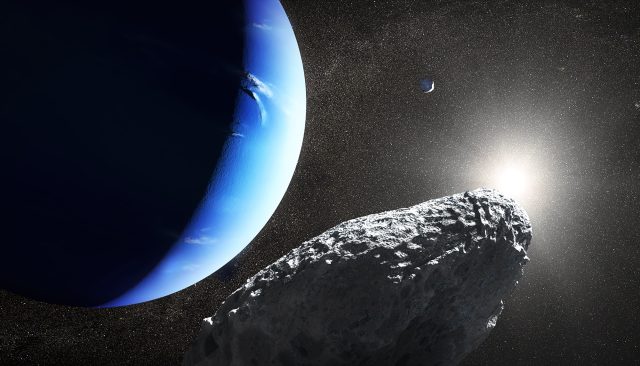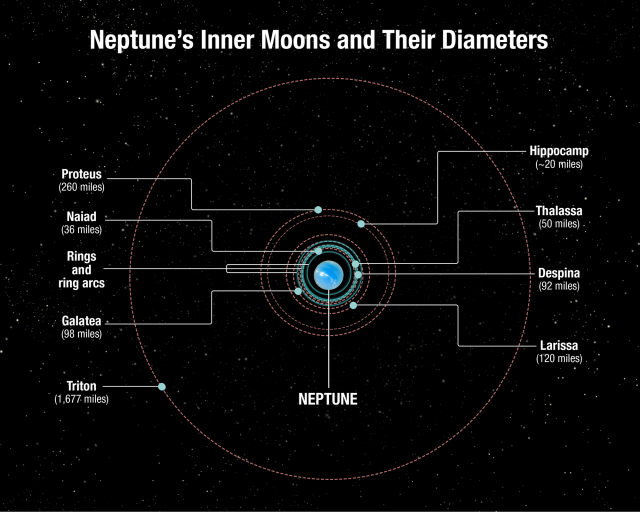
As the Voyager probes moved through the outer Solar System, they compiled a massive record of discovery. Among the newly found objects and phenomena were a large collection of small moons orbiting Jupiter, Saturn, Uranus, and Neptune. Most of these were beyond the ability of Earth-based hardware to image at the time—we actually had to be there to see them.
Since then, however, improvements in ground-based optics and the existence of the Hubble Space Telescope have enabled us to find a few small bodies that had been missed by the Voyagers, as well as other small objects elsewhere in the Solar System, such as the Kuiper Belt object recently visited by New Horizons. Now, researchers have found a way to use advances in computation to increase what we can do with imaging even further, spotting a tiny new moon at Neptune and possibly spotting another for the first time since Voyager 2 was there.
Finding moons
Given that Neptune has been visited by Voyager 2 and imaged frequently since then, any moons we haven't already spotted are going to be pretty hard to see, presumably because they're some combination of small and/or dim. The simplest way to see them is to increase the exposure time, allowing more opportunity for dim signals to emerge from the noise. This method won't work if there's a bright object nearby, which isn't so much of a problem with the outer planets.
What is a problem are the previously discovered moons orbiting close enough to the moons to move noticeably within the time span of a single exposure. At some point, this movement creates a "smear" that keeps the signal firmly embedded in the noise.
A small team of researchers from SETI, NASA, and Berkeley has figured out a way of compensating for this smear. If you know a body's orbit, you can predict how much it will move from one image to the next. You can then adjust multiple consecutive images to put objects in the same orbit at the same location, allowing any signals to stand out. The transformation can get tricky because the orbit may be skewed at an odd angle from the imaging device. But it's well within our current computational abilities.
The problem is that if we don't know the moon exists, then we obviously don't know its orbit. But the team behind this new research has come up with functions that work for any moon moving in a forward, circular orbit around the equator of a planet.
"One can use these functions to transform an image taken at time t0 to match the appearance of another image obtained at time t1 by relocating each pixel in the original image to a new location," the team members write. "After the transformation, any moon on a prograde, circular, equatorial orbit will appear at fixed pixel coordinates."
The researchers applied this method to Neptune, where Voyager 2 had discovered a set of small moons, using a set of images taken from an entire orbit of the Hubble.
Discovery and rediscovery
When the analysis was done, a tiny moon popped out. Now named Hippocamp, after the mythical sea monster, it's only about 35km across and orbits near the outer edge of this cluster of moons. The same analysis picked up the moon Naiad, which had been spotted by Voyager 2. But Naiad wasn't where we expected it to be; in fact, it was off by 180°. But an orbit that places it in the correct location is possible with a small adjustment to the orbit predicted from Voyager data. Unfortunately, that means that a couple of claims of having spotted it using ground-based instruments in recent years are almost certainly wrong.
With three observations made up to a dozen years apart, it's possible to calculate Hippocamp's orbit well enough to determine where it would have been during Voyager 2's flyby. Most imaging missed that region of space, and the few images that didn't all showed significant smear. So there was no real way to have identified this moon prior to recent imaging campaigns.


Hippocamp's orbit is just inside that of Proteus, the largest of Neptune's inner moons. Tidal forces are causing Proteus to slowly edge away from Neptune, but Hippocamp is so small that these forces will have a minimal effect on it. And that implies that the two bodies were once much, much closer. Proteus has a large crater, Pharos, where an impact blasted away 50 times the volume of Hippocamp, suggesting that there was more than enough debris around to form the tiny moon.
One of the problems with this idea is that the close proximity to Proteus should have thrown Hippocamp into an eccentric orbit. But the researchers suggest this isn't as much of a problem as it seems. Based on the crater rates and sizes on Proteus, they estimate that collisions large enough to wipe Hippocamp out entirely would have happened at least nine times since its formation. The process of destruction and re-formation should allow the moon to occupy progressively more regular orbits.
That model, however, suggests that it and possibly other small moons near Neptune have experienced multiple destructions over the course of their history rather than simply having been put in place during Neptune's formation. And there's lots of material unaccounted for, which suggests there may be some sparse rings in the region that will be difficult to detect without another visit to the blue planet.
Nature, 2019. DOI: 10.1038/s41586-019-0909-9 (About DOIs).
https://arstechnica.com/science/2019/02/researchers-develop-a-technique-that-spots-tiny-moon-orbiting-neptune/Bagikan Berita Ini















0 Response to "Hubble images show a Neptune moon that may have been repeatedly reborn - Ars Technica"
Post a Comment